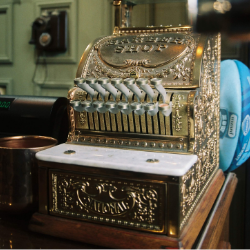Show Deals – An Overview
 A deal is a deal, is a deal; But which one to use?
A deal is a deal, is a deal; But which one to use?
In theory, a deal is an exchange of something, usually money, for a product or a service. In our case, it’s usually money for a performance and it’s a booking agent’s job to strike the best deal for the artist.
Show deals usually fall into the following different types:
Flat Fee Deals
This is the simplest type of deal, the artist delivers a performance for a fixed fee. Typically, we use the flat fee for festival bookings, private and corporate events. The artist has no opportunity of earning more than the fee agreed in the first place, so the agent will usually push to obtain the highest amount possible.
It’s rare to use a flat fee for a headline show since the artist will want to earn a % based on ticket sales if the show sells well. However, if the performance room is small, then a flat fee can cut out unnecessary admin.
Some promoters are better at dealing with % than others. There are times we will do a higher flat fee, instead of a split deal simply because we want to avoid a settlement after the event.
Support performances are nearly always a flat fee.
Contract deal line examples:
- £3,000 + VAT Flat Fee + catering
- £2,500 Flat Fee + catering
The fees for the following deals depend on the ticket price, the number of tickets sold, the venue’s capacity, and the promoter’s show costs. The agent must consider all these variables in a split deal…
There are several different types of split deals…
 The Straight Split
The Straight Split
In this case, all the income from a show is added up, then taxes (such as VAT), box office commission (BOC), performing rights (PRS), and any credit card fees are taken off. The remaining amount is called the Net Box Office Receipts often abbreviated to NBOR. This NBOR is split according to the agreed %.
The venue’s costs are absorbed into their % of the split, so the % to the artist is often lower than other deals. There are some venues that will do this deal in-house and it can be a really great deal for the artist. Remember for every ticket that is sold a portion of the money is coming to the artist. As long as the artist’s costs are low, that may well be a risk worth taking. Outside promoters will never do this deal, it’s way too risky for them, especially if they have a fixed venue hire to contend with.
A typical straight split would be 70/30 in the artist’s favour.
(We usually write this deal like versus deal with the guarantee set to £0, this is not necessary, but highlights that there is no guarantee)
Contract deal line examples:
- £0 vs 70% NBOR to the artist
The Split After Costs
In this case, once the NBOR has been deduced, the promoter’s agreed costs are taken off, before the split is applied. This is a very risky deal for the artist since they have to sell a significant amount of tickets to cover the promoter’s costs before they start to make a fee. Avoid this deal!
Contract deal line examples:
- £0 vs 80% after agreed costs
- £0 vs 80% + VAT after £200 costs
The Versus Deal
The most common deal for a headline show. This is the same as a split deal after costs, with one crucial difference; the artist is also guaranteed a certain amount regardless of the split. In this deal, if the guarantee is higher than the split – the artist gets the guarantee, if the split is higher, they get the split. It’s one OR the other – whichever is the higher. Occasionally you will see a versus deal with no costs, however, this is quite rare.
A typical %, in this case, would be 80%.
Contract deal line examples:
- £2000 versus 80% + VAT after agreed costs of £800
- £1500 vs. 80% + VAT of NBOR
(In both the above cases the artist is registered for VAT. It is vital to include it in the deal line of the contract and the artist’s VAT number on the invoice. More on VAT another time!)
The Plus Deal
Very similar to the versus deal, this benefits the promoter at lower sales, but rarely makes much difference to potential income on sell-outs. The main way to spot a “Plus Deal” is you will see the artists guaranteed fee in the show costs as well as a line for promoter profit. This means that once the show costs and the guarantee are covered by sales income, then the promoter profit is covered. Only once that has been paid off is the split applied. The level of promoter profit is crucial and needs to be noted. A typical amount would be 15% of all show costs. Or 25% of guarantee.
Unlike the versus, the guarantee is paid PLUS a % on top, if the show can afford it. It’s not an either-or scenario
Contract deal line examples:
- £800 + 75% + VAT after agreed costs to include £200 promoter profit
- £1000 + 80% after agreed costs of £1000
 The Call Deal
The Call Deal
We only ever see this deal in theatres that do deals with theatrical production companies. This deal considers the NBOR as a “pot” of money from which “Calls” of money are taken. For example, the first call of £1000 to the Artist, the second call of £500 to the venue, the third call is a 70% split to artists.
The important thing to note about this deal is there is the first call is not the same thing as a guarantee. The first call is for £1000, but if the NBOR “pot” is only £800, then the artists would only get £800. Agents rarely instigate this deal.
Contract deal line examples:
- £1000 First Call to the artist, £500 Second call to the venue, 70% Third call to the artist.
A Word On Costs…
When a promoter makes an offer they will send you their costs. These are estimates. Then at the end of the process, the agent needs to assess show costs in the artist settlement. If the show has covered or come close to covering artist guarantee and show costs, then the agent should ask for an updated budget of actual costs.
A Gross Deal
This can apply to all types of deals.
Sometimes the artist is registered for VAT and the promoter is not. If VAT were added onto the final artist’s fee the promoter would not be able to claim it back and so have almost no way of making any income. When this happens the agent should strike a gross deal.
Firstly ignore the artist’s VAT liability to arrive at the artist’s gross fee. Then work out the artist’s fee and their VAT by dividing it by 1.2
For example, let’s assume the deal is £1,200 vs 80% after costs (Gross deal). If we assume the final fee due to the artist was £1,650. The first invoice for the guarantee would be for £1,200 and the second would be £450 – but we need to account for VAT within these figures so…
1200 / 1.2 = £1000 + VAT
450 / 1.2 = £375 + VAT
This amounts to £1,650

